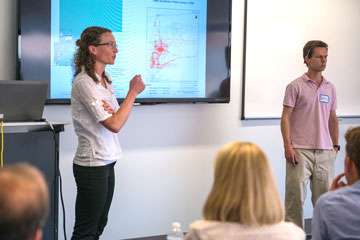Planning students Yelena Onnen, left, and Watkins Fulk-Gray present findings of their analysis of Weld County transportation patterns as part of the Walk and Wheel project. Credit: Jesse Kuroiwa, College of Architecture and Planning
In their research into transportation patterns in Weld County, land-use planning students Watkins Fulk-Gray and Yelena Onnen found that 78 percent of work trips are in single-occupant vehicles. Of those trips, 44 percent take 20 minutes or less and 13 percent take 10 minutes or less.
"A fair number of people commute pretty short distances," Fulk-Gray said. "It could be that they just lack the facilities to commute in other modes."
Their analysis is part of a Walk and Wheel Class Project: The Potential for Increasing Active Travel in Seven Colorado Communities. In Weld County, which is larger than Rhode Island and Delaware combined, the opportunities for more pedestrian and bicycling activity are likewise vast.
The students in the Transportation and Land-Use Planning class presented findings from the Walk and Wheel project on April 28 and May 5 in the CU Building on the CU Denver campus. Kaiser Permanente Colorado Community Benefit created the Walk and Wheel grant program, which awards funds to help communities become more bicycle and pedestrian friendly.
The students conducted SWOT (strengths, weaknesses, opportunities, threats) analyses in seven communities—Lafayette, Pueblo, Fort Collins, Weld County, Greeley, Milliken and Colorado Springs.
Weld County's walking/bicycling strengths include its flat, accessible geography, urban neighborhoods in Greeley that are conducive to alternative transportation modes and a well-educated, high-income population.
Its weaknesses include inconsistent signage, narrow shoulders on county roads and a lack of active transportation facilities. "As a recreational cyclist, Weld County has some great potential—county roads can be great to cycle on," Onnen said. "But I wouldn't want to tangle with some of that equipment (oil and gas vehicles) on the roads."
Onnen and Fulk-Gray concluded that opportunities in Weld include improved alternative travel connections in high-traffic corridors, rails-to-trails initiatives and greater emphasis on education about walking/bicycling.
Another student in the class, Rachael Bronson, focused her research on the city of Greeley. In her presentation, Bronson concluded, "With the growth in Greeley, we'll see more traffic congestion and a great opportunity for more bike lanes and sidewalks to relieve some of that congestion."
Co-leading the project with Kaiser Permanente are Carey McAndrews, Ph.D., assistant professor in the Department of Planning and Design, College of Architecture and Planning, and Jill Litt, Ph.D., associate professor in the Colorado School of Public Health. "We thought this project was a good example of interdisciplinary research and practice," said Litt, who is in the Department of Environmental & Occupational Health at the Colorado School of Public Health.
Litt and McAndrews are also faculty for the joint degree in Urban and Regional Planning and Public Health (MPH-MURP). McAndrews said the program is "building a cohort of students who are being trained in this kind of practice—the intersection of transportation and health and, more broadly, health and the built environment."
In their investigation of various communities, students have employed a mixed method of research—audit instruments, interviews and other research tools. It's another example of how professors at the University of Colorado Denver | Anschutz Medical Campus emphasize project-based education, encouraging students to solve real-world problems in collaboration with communities.
"We're training future generations of planners and public health professionals to work at the intersection of the areas of land-use planning and public health—to look at problems in an interdisciplinary way," McAndrews said.
Regional land-use planners and public works professionals from the various communities listened with interest to the students' findings. One Weld County planner told Onnen and Fulk-Gray that the corridors they identified for more bicycling/walking were the same ones her staff had targeted for improvement. "You've confirmed what we've been looking at," she said.
Provided by University of Colorado Denver





















